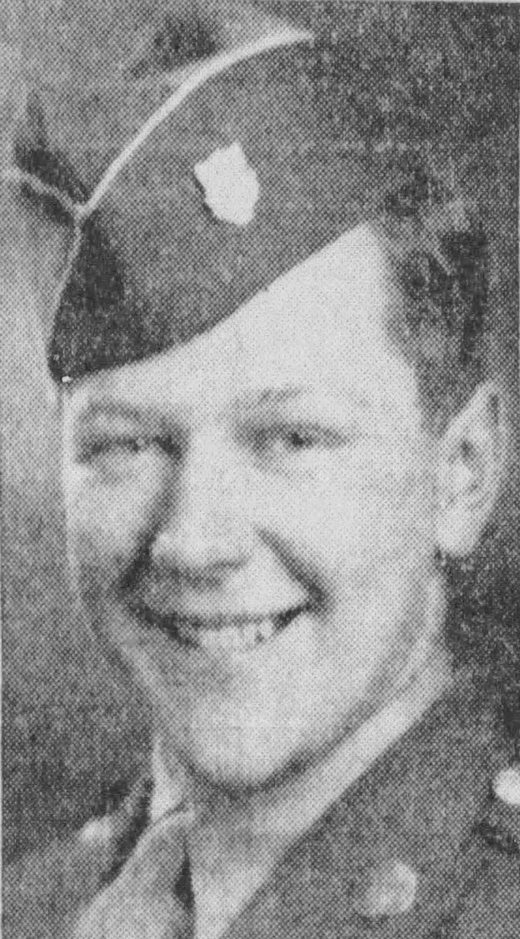Army PFC Gerald Wipfli, killed in World War II, was finally returned to his family and, on September 23, 2017, laid to rest - in American soil - with full military honors.
Born February 13, 1923, in Nekoosa, Wisconsin, Gerald was blessed to the union of Son of Dominick and Anna (nee Bricker) Wipfli.
Bud attended school in Nekoosa and worked at Nekoosa Port Edwards Paper Company for a short time before entering the Army in September of 1942. Bud attended school in Nekoosa and worked at Nekoosa Port Edwards Paper Company for a short time before entering the Army in September of 1942.
In early November 1944, PFC Wipfli was a member of Company I, 3rd Battalion, 112th Infantry, when his unit was engaged in intense combat against German forces in the town of Schmidt, Germany, within the Hürtgen Forest. Due to chaotic fighting, 112th Infantry officers were not able to accurately report the status of each soldier, and it took several days for Company I to gain accountability of their casualties. Gerald was among 33 soldiers listed as missing in action from his company. No surviving members of his unit had information on his fate, and PFC Wipfli was reported missing in action on Nov. 4, 1944.
German forces did not report Wipfli as being taken prisoner, and American forces did not retake Schmidt until February 1945. However, none of the remains that were found during initial searches were identified as Wipfli.
Following the end of the hostilities, the American Graves Registration Command (AGRC), U.S. Army Quartermaster Corps, was the unit tasked with investigating and recovering missing American personnel in the European Theater. The AGRC conducted several investigations and recoveries; however, PFC Wipfli's remains were not found. On Dec. 15, 1950, having received no further evidence on Wipfli, he was declared non-recoverable.
Along with his parents, left to mourn his passing were siblings; Joseph E. Wipfli, Helen Gray, Josephine Ann (Mrs Clarence) Paulson, Margaret Martin, Eleanor Rose (Mrs Harold) Hostetter, George Dominick Wipfli, Edmund Frank Wipfli, Genevieve Mary Weinbauer, Madeline Antoinette (Mrs Roger) Brown, MaryAnn Moreau, Geraldine Garcia and Elizabeth "Betty" Michels. (Gerald was preceded in death by his oldest sister, Bertha Ann (Mr Charles) Stellmacher.)
On April 16, 2010, workers of the Rheinisch-Westfälisches Elektrizitätswerk (RWE) power company unearthed osseous remains while installing electrical lines in Schmidt. The RWE notified the Voklsbund Deutsche Kriegsbraberfursorge e. V. (VdK, German War Graves Commission), which excavated the site. The VdK notified the Deputy U.S. Forces Liaison Officer and U.S. Army Mortuary Affairs Activity-Europe of the recovery. The remains were sent to the Central Identification Laboratory in Honolulu for analysis on May 11, 2010.
To identify Gerald's remains, scientists from DPAA and the Armed Forces Medical Examiner System used mitochondrial (mtDNA) and autosomal (auSTR) DNA, which matched his sister and niece; anthropological analysis, which matched PFC Wipfli's records; and historical evidence. (The support of the German government was vital to the success of this recovery.)
Bud's family was notified on July 27th of 2017 that his remains had been located in Schmitt, Germany by a Utility Company laying cable in 2010 - he was identified by DNA testing.
Gerald was finally returned to his family. Services were held at Sacred Heart Church with burial following at Riverside Cemetery, next to his mother and father in Nekoosa., with full military honors.
Gerald is survived by his baby sister, Elizabeth (Wipfli) Barth Michaels, many nieces and nephews and special friends Ed and Anita Tiebax of the Netherlands. Gerald was preceded in death by his parents Dominick and Anna Wipfli, 3 brothers George, Edmund, and Joseph Wipfli. 9 sisters Bertha Stellmacher, Helen Gray, Josephine Paulson, Margaret Martin, Eleanor Hostetter, Genevieve Weinbauer, Madeline Brown, MaryAnn Moreau, and Geraldine Garcia.
Through the work of the Defense POW/MIA Accounting Agency, the remains of Wipfli were accounted for in 2017, and his name remains permanently inscribed on the Tablets of the Missing at Henri-Chapelle American Cemetery.
rosetta medalWhen an individual’s remains have been accounted for by the U.S. Department of Defense, a rosette is placed next to the name on the Wall/Tablet/Court of the Missing to mark that the person now rests in a known gravesite.
Source: Find a Grave

PRIVATE CITIZENS SUPPORTING AMERICA'S HERITAGE
American
War Memorials Overseas, Inc.
War Memorials Overseas, Inc.
Wipfli Gerald F. 'Bud'
Name:
Gerald F. 'Bud' Wipfli
Rank:
Private First Class
Serial Number:
36267007
Unit:
112th Infantry Regiment, 28th Infantry Division
Date of Death:
1944-11-09
State:
Wisconsin
Cemetery:
Riverside Cemetery Nekoosa, Wood County, Wisconsin
Plot:
Row:
Grave:
Decoration:
Bronze Star; Purple Heart
Comments:
